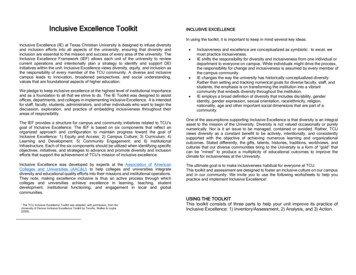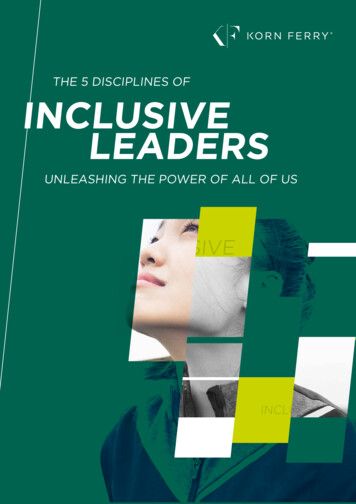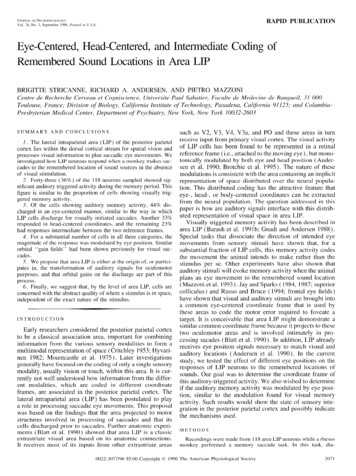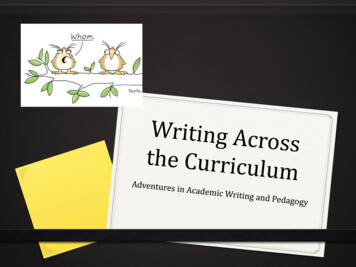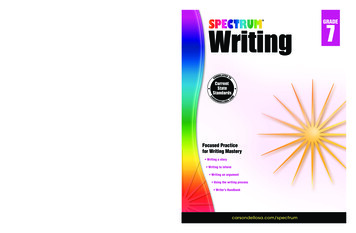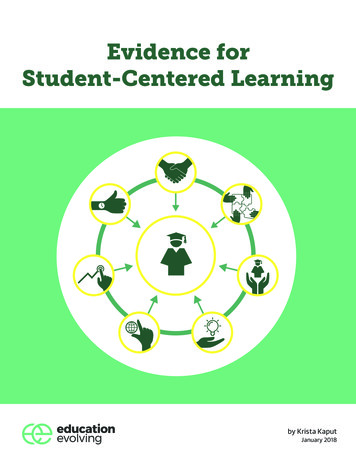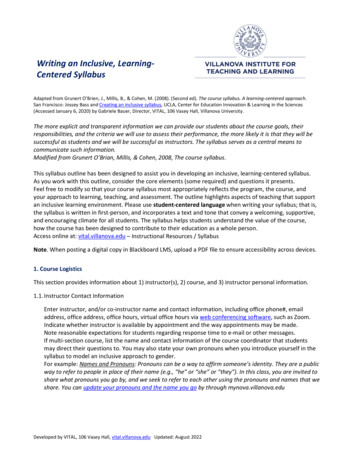
Transcription
Writing an Inclusive, LearningCentered SyllabusAdapted from Grunert O’Brien, J., Millis, B., & Cohen, M. (2008). (Second ed). The course syllabus. A learning-centered approach.San Francisco: Jossey Bass and Creating an inclusive syllabus, UCLA, Center for Education Innovation & Learning in the Sciences(Accessed January 6, 2020) by Gabriele Bauer, Director, VITAL, 106 Vasey Hall, Villanova University.The more explicit and transparent information we can provide our students about the course goals, theirresponsibilities, and the criteria we will use to assess their performance, the more likely it is that they will besuccessful as students and we will be successful as instructors. The syllabus serves as a central means tocommunicate such information.Modified from Grunert O’Brian, Millis, & Cohen, 2008, The course syllabus.This syllabus outline has been designed to assist you in developing an inclusive, learning-centered syllabus.As you work with this outline, consider the core elements (some required) and questions it presents.Feel free to modify so that your course syllabus most appropriately reflects the program, the course, andyour approach to learning, teaching, and assessment. The outline highlights aspects of teaching that supportan inclusive learning environment. Please use student-centered language when writing your syllabus; that is,the syllabus is written in first-person, and incorporates a text and tone that convey a welcoming, supportive,and encouraging climate for all students. The syllabus helps students understand the value of the course,how the course has been designed to contribute to their education as a whole person.Access online at: vital.villanova.edu – Instructional Resources / SyllabusNote. When posting a digital copy in Blackboard LMS, upload a PDF file to ensure accessibility across devices.1. Course LogisticsThis section provides information about 1) instructor(s), 2) course, and 3) instructor personal information.1.1. Instructor Contact InformationEnter instructor, and/or co-instructor name and contact information, including office phone#, emailaddress, office address, office hours, virtual office hours via web conferencing software, such as Zoom.Indicate whether instructor is available by appointment and the way appointments may be made.Note reasonable expectations for students regarding response time to e-mail or other messages.If multi-section course, list the name and contact information of the course coordinator that studentsmay direct their questions to. You may also state your own pronouns when you introduce yourself in thesyllabus to model an inclusive approach to gender.For example: Names and Pronouns: Pronouns can be a way to affirm someone’s identity. They are a publicway to refer to people in place of their name (e.g., “he” or “she” or “they”). In this class, you are invited toshare what pronouns you go by, and we seek to refer to each other using the pronouns and names that weshare. You can update your pronouns and the name you go by through mynova.villanova.eduDeveloped by VITAL, 106 Vasey Hall, vital.villanova.edu Updated: August 2022
Page 2 of 61.2. Course InformationCourse title, number, section, semester offered, days, times of course meetings (EST) and location.List any dates, times of special sessions, field trips, other activities that are scheduled in place of/inaddition to regularly scheduled class meetings. Note any prerequisites for student enrollment, special skillsor knowledge for effectively meeting course requirements.Provide an accessibility statement that invites students to contact you, such as:Universal Learning: I am committed to the principle of universal learning. This means that our classroom,our virtual spaces, our practices, and our interactions be as inclusive as possible. Mutual respect, civility,and the ability to listen and observe others carefully are crucial to universal learning.Any student with physical ability issues should contact the Office of Disability Services at the start of thesemester to coordinate appropriate accommodations. Then you and I will work together to ensure youracademic success in this course as well as appropriate accommodations needed for this course.1.3. Instructor Personal InformationYou may share your interest in the subject, your teaching philosophy. You may introduce co-instructors,outline their expertise, and share how they will contribute.1.4. Land Acknowledgement StatementWe invite you to share a land acknowledgement statement to recognize those who first lived on the landwhere Villanova University resides. You may share the following statement prepared by the PennsylvaniaYouth Congress in 2020.We recognize and acknowledge Pennsylvania as being the land of the Erielhonan (Erie), Haudenosaunee(Iroquois), Lenni-Lenape, Shawnee, Susquehannock, and Tuscarora nations, and the Honniasont, Saluda,Saponi, Tutelo, and Wenrohronon tribes. We pay respect to the Native peoples of Pennsylvania past,present, and future and their continuing presence in their homeland and throughout their diasporas.2. Academic Program and Course Student Learning Outcomes2.1. Course DescriptionIndicate how the course fits within the program, its value added for the students, its content.You may indicate the course format, e.g., seminar course, interdisciplinary, team-taught course.2.2. Program Student Learning OutcomesIndicate how the course learning outcomes align with the academic program outcomes:what academic program goals are addressed in the course? You may outline this alignment by listing eachprogram goal relevant to a particular course goal. You may also list accreditation or certificationrequirements, as appropriate.For example, in this course students articulate their data collection process by writing lab reports [courselearning goal] - this goal contributes to students' ability to present written and oral reports of technicalinformation clearly and concisely [academic program goal].
Page 3 of 62.3. Course Student Learning OutcomesState the course learning outcomes, including knowledge, skills, and competencies to be achieved. Informthe students how the course contributes to their learning. Use concrete verbs (e.g., identify, compare,appraise, estimate, predict) to articulate student learning outcomes and make them observable andmeasurable. The learning outcomes guide the design of assessments and in- and out-of-class activities.Sample learning outcomes:-- Create interactive 3-D models of products using VRML.-- Use energy principles to determine the stress states of structures comprised of one-dimensionalelements (beams, columns, and rods).-- Solve geometric problems concerning planes using vectors.3. Assignments / ExamsDescribe all academic requirements in the course, such as types of assignments, tests, exams, papers, projects,homework, quizzes, exhibits, presentations that students will complete and indicate how they will helpstudents achieve the intended learning outcomes. Indicate how each assignment contributes to the finalcourse grade, such as percentage or points earned per assignment. List the dates when these requirementsoccur, or assignments are due.Provide opportunities for practice and give students frequent feedback on their learning using low-stakesassessments (e.g., homework, reading quizzes, reflections). Require multiple high-stakes assessments (e.g.,papers, performances, projects) with opportunities to revise and resubmit where students may demonstratetheir mastery of learning outcomes. Link assignments to learning goals, explain to students what they will gainfrom completing assignments (besides the grade).4. Grading / Course Policy4.1. Grading PolicyState instructor grading policy, including the weight attached to all assignments/exams listed in thesyllabus, including team work and class participation, as appropriate. Note how final grade is calculatedand outline grade distribution. Set forth when/how students will receive feedback on their work andreasonable expectations about returning graded work. Set forth instructor policy regarding attendance,participation, missed assignments, late work, and extra credit. Please note the attendance policy for firstyear undergraduate students. Outline instructor policy regarding participation in webinars, field trips orother activities that are scheduled in addition to and/or in place of regularly scheduled class meetings.4.2. Course PoliciesOutline policy pertaining to academic integrity, student safety (lab), civility (e.g., use of cell phones,laptops), and academic accommodations. For example, Eating and drinking are not permitted in the lab.Please do not bring any food or beverages into the lab. We will be working with hazardous materialsthroughout the semester. Eating or drinking during lab puts you and your classmates at increased risk ofaccident and injury from breakage or toxins. You will be asked to remove any food or beverage you bringinto the lab. Please turn off your cell phones so that you can focus on the lab work at hand.Provide a statement about academic integrity, such as When students come to Villanova, they join anacademic community founded on the search for knowledge in an atmosphere of cooperation and trust.Students must be honest and forthright in their academic studies. To falsify the results of one's research, tosteal the words or ideas of another, to cheat on an assignment, or to allow or assist another to committhese acts corrupts the educational process. Students are expected to do their own work and neither givenor receive unauthorized assistance. Please familiarize yourself with the Code of Academic Integrity: rces/student/policies/integrity.html
Page 4 of 6Students are encouraged to visit the Academic Integrity Gateway, complete the interactive quiz, and referto this site as a resource: s/academicintegrityProvide a statement about academic accommodations, such as It is the policy of Villanova to makereasonable academic accommodations for qualified individuals with disabilities. All students who needaccommodations should go to Clockwork for Students via myNOVA to complete the Online Intake or tosend accommodation letters to professors. Go to the LSS website http://learningsupportservices.villanova.edu or the ODS website - www1.villanova.edu/university/studentlife/ods.html for registration guidelines and instructions. If you have any questions please contact LSS atlearning.support.services@villanova.edu or 610-519-5176, or ODS at ods@villanova.edu or 610-519-3209.Include a statement about absences on religious holidays, such as Villanova University makes everyreasonable effort to allow members of the community to observe their religious holidays, consistent withthe University’s obligations, responsibilities, and policies. Students who expect to miss a class or assignmentdue to the observance of a religious holiday should discuss the matter with their professors as soon aspossible, normally at least two weeks in advance. Absence from classes or examinations for religiousreasons does not relieve students from responsibility for any part of the course work required during theabsence. Please refer ources/student/policies/religiousholidays.html5. Teaching Methods and MaterialsConvey to the students your commitment to create and foster an equitable and inclusive learningenvironment. You may include the link to Villanova’s Diversity Statement and/or articulate your own.Describe the nature of instructional activities that will occur to help students accomplish set learningoutcomes, such as teamwork, debates, interactive lecture, online discussions, use of Blackboard, clickers.Outline the nature of interactions and students' responsibility in their learning: student-led discussions,presentations, peer feedback, self-assessment. Note whether you will collect student feedback forinstructional enhancement purposes.List all required readings, courseware, digital subscriptions, learning materials, instructional supplies,equipment that students are expected to use in the course and indicate where they may be obtained. Pleasefamiliarize yourself with the Villanova Copyright Policy.Course material costs may pose a financial hurdle for some students. Please try to adopt affordable coursematerials. Subject librarians can assist with finding library subscribed content and open educational resources(OER). Refer to the Affordable Materials Project website for guidance and resources to select high quality,affordable course materials.
Page 5 of 6Include a statement about affordable materials in your syllabus, such as Villanova University is committed toproviding affordable options for students to obtain textbooks and course materials. Here are some tips on howto save money:1. Search Falvey Library Collection to see if your books are available. https://library.villanova.edu/Find/2. Search Course Reserves for short term loans. If a book is unavailable, ask your professor to place acopy on Reserve. 3. Borrow from other libraries via E-ZBorrow . Find deals at the bookstore including rental and price matching programswww.villanovabookstore.com5. Faculty, academic advisors, and librarians are prepared to help you navigate access to coursematerials. Please reach out for assistance.For more tips and information on how to access the options above, please visit Villanova’s Affordable MaterialsProgram (AMP) website (https://library.villanova.edu/amp/students.html) or search for “AMP,” VU homepage.Note. According to the Higher Education Act (HEA), indicate the following information for required/recommended textbooks, course packs and material such as software, website access, cases or simulations:the ISBN, the retail price. If the ISBN is not available, please provide the author/creator, the title, the publisher,and the copyright date: eredact.html 6. Learning and Personal ResourcesDescribe how students can succeed in the course and offer study tips, resources, study guides, such as:Guide to the readings - Keep an open mind. Listen to what the readings have to say. Think about whatexperiences you may have had and reading you have done that may corroborate the course readings. Giveyourself time to reflect on the information offered in the readings. Take your time with the readings; allowyourself to enter into a kind of conversation with them.Outline how the faculty member and/or peer instructor will work with students; e.g., facilitate study groups,conduct review sessions prior to exams. Include tips from former students who have been successful in thecourse. You may also include links to Villanova Student Service offices that pertain directly to your course, suchas Learning Support Services, Mathematics Learning Resource Center, and Writing Center.You may also include information on how students can access resources that support their personal andphysical well-being, such as the Student Health Center, the Counseling Center, and the Office of HealthPromotion. Sample statement, College can be quite stressful and challenging. Counseling Centers are there tosupport all students and they are a great resource. The Counseling Center sees more than 1400 students a yearand the counselors can help you be more effective; the consultations are confidential.You may include a basic needs statement to convey to students that you are committed to supporting them inhaving their basic needs met (e.g., food, shelter, safety) so they can focus on their studies and utilize themultiple opportunities that the college experience offers. Please find a sample basic needs statement from theHope Center for College, Community, and Justice below.We learn as whole people. To learn effectively we must have basic security: safe shelter, sleep, and nutrition.If you‘re having difficulty with any of these essential things, please talk with me or the Dean of Students.Together we can work to ensure that your needs are met. We are here to support you.
Page 6 of 67. Course CalendarList the sequencing of content areas, respective readings, schedule of course activities chronologically by classperiod for the entire semester. State dates, times when all academic requirements in the course need to becompleted and submitted. Indicate dates for formative and summative student feedback, note drop-add dates,official holidays, breaks, and dates you will be away from campus. Refer to the academic calendar for observedholidays and breaks. From the course calendar students should have a clear understanding of theirresponsibilities for each week.8. DisclaimerYou may wish to include a disclaimer about possible changes to the course calendar. For example,This syllabus is intended to outline how the course will be conducted, how you will be engaged in learning thesubject matter, and how your learning will be assessed and will be followed as closely as possible. However, theprofessor reserves the right to modify, supplement aspects of the course as needs arise. You will be informedabout these modifications in a timely fashion.
learning.support.services@villanova.edu or 610-519-5176, or ODS at ods@villanova.edu or 610-519-3209. Include a ; statement about absences on religious holidays, such as ; Villanova University makes every reasonable effort to allow members of the community to observe their religious holidays, consistent with
